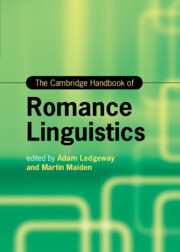Book contents
- The Cambridge Handbook of Romance Linguistics
- Cambridge Handbooks in Language and Linguistics
- The Cambridge Handbook of Romance Linguistics
- Copyright page
- Dedication
- Contents
- Figures
- Tables
- Contributors
- Abbreviations
- 1 Data, Theory, and Explanation: The View from Romance
- Part One What Is a Language?
- Part Two Phonetics and Phonology
- Part Three Morphology
- Part Four Syntax
- Part Five Semantics and Pragmatics
- Part Six Language, Society, and the Individual
- Index
- References
1 - Data, Theory, and Explanation: The View from Romance
Published online by Cambridge University Press: 23 June 2022
- The Cambridge Handbook of Romance Linguistics
- Cambridge Handbooks in Language and Linguistics
- The Cambridge Handbook of Romance Linguistics
- Copyright page
- Dedication
- Contents
- Figures
- Tables
- Contributors
- Abbreviations
- 1 Data, Theory, and Explanation: The View from Romance
- Part One What Is a Language?
- Part Two Phonetics and Phonology
- Part Three Morphology
- Part Four Syntax
- Part Five Semantics and Pragmatics
- Part Six Language, Society, and the Individual
- Index
- References
Summary
In this chapter the editors introduce the book and its aim of showing how the study of comparative and historical data from the Romance languages can illuminate general linguistics. After a brief presentation of the volume and its structure, the editors reflect on how their personal experiences of working with data from the Romance languages have led them to reflect on wider issues in general ling uistics. Recurrent themes in their work have been, respectively, morphosyntactic change (Ledgeway) and sound change and its morphological consequences (Maiden). Among the topics whose theoretical implications are explored are: parametric variation, universals, typological variation, pro-drop, word order, linguistic theory and philology, complementizer systems, the interaction of phonological and morphological factors in morphologization, the problem of defining a language family, and the perils of ‘standard language bias’ in the practice of historical linguistics. While these may appear a quite heterogeneous set of issues, they are treated in a way that prompts some major shared fundamental conclusions, in particular that Romance linguistics can make its most powerful contributions to general linguistics when Romance linguists exploit to the maximum the extraordinary wealth of historical and comparative data which the Romance languages and dialects offer them.
Keywords
- Type
- Chapter
- Information
- The Cambridge Handbook of Romance Linguistics , pp. 1 - 94Publisher: Cambridge University PressPrint publication year: 2022



